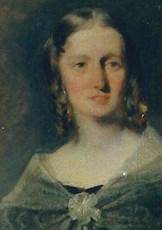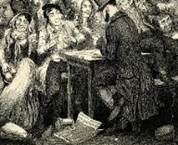The rise of literacy
In the early 19th century literacy was spreading fast, frequently promoted for the ability to read the Bible. Education in any broader sense, even writing and maths, was still seen by the educated as dangerous because it might undermine the willingness of the poor to labour.
Public provision of education was meagre to non-existent and the rising literacy owed little to government intervention. Meanwhile, new industries were calling for better educated workers, in particular clerks.
Schools organised by employers and religious, industrial and local government bodies developed to meet the need, but their coverage continued to be haphazard until 1870 when an Act on compulsory schooling was passed.
The first education mandated by law was for the children employed in cotton mills. Apprentices had to be given instruction in reading, writing and arithmetic (Factory Act 1802). Minimal as it was, this covered many children from the age of seven.
An Act of 1819 forbade the employment of children under nine in cotton mills and required two hours’ education a day for children up to the age of 13. In 1833, an Act extended this to all textile mills, except silk mills.
These Acts imposed the duty to educate on employers. From 1835, local authorities elected by rate-payers were authorised to finance and take over local functions. This spread to social welfare, which was often the most pressing local need. Only a small amount of money was allocated to education by central government.
Schools then sprang up in places where rate-payers or other benefactors were sufficiently enlightened, but these were unevenly distributed around the country, leaving most congested urban areas without.
The Church was already a national source of literacy. Early in the 19th century, the Church set up regular schools and persuaded Parliament to provide some funding. Both the established and the nonconformist churches ran Sunday schools that taught adults as well as children, albeit only how to read the Bible.
None of these could match the higher levels of literacy and numeracy needed to meet the more complex requirements of the industrial revolution. As it was industry that had the need, government felt it could wash its hands of the problem.
Voluntary facilities soon developed, starting with the Mechanics’ Institutions in the 1820s. Industry schools then started to take younger children, providing a basic education alongside vocational skills. Infant schools were started as a child-minding service for the under-sixes whose parents worked. Some of these developed into elementary schools taking children up to the age of 12.
In 1830, the government allocated money for school building and expanded it over the years. By 1860, the proportion of children who received an average of two years’ education had risen to about 85%.
However, in the 1860s, two thirds of towns still had no secondary school at all. This prompted three official reports that set the model for a century. One covered private schools, another the handful of old foundation schools, and a third, education for the rest.
The 1870 Act and amendments in the following decades subdivided schools three ways: a liberal education until 18 as preparation for university; grammar schools until 16 for the middle classes; and low-level basic education until 13 for everyone else.
Comparisons with modern rates of literacy are misleading. In Lloyd’s day it was the absolute measure — someone either could or couldn’t read. The modern measurement puts the absolutely illiterate at less than 1%, yet it also places the “functionally illiterate” at 16% (adults with a reading age of 11 or less).
No comparable test was applied in Lloyd’s day and we have no way of telling how many of the literate would have been able to master the literary style of Lloyd’s publications. It certainly set the bar to “functional” very high compared with today’s tabloid style. The popularity of his works suggests that contemporary reading skills were impressive.
Literacy spread rapidly in Lloyd’s time, but a more insidious divider — broad-based education — continued to do the work that illiteracy had done in pre-industrial times. The poor were not taught the same subjects as the middle classes or to acquire a breadth of knowledge beyond the street, neighbourhood, village or town.
Lloyd’s newspapers would have helped the curious to learn about the unfamiliar and possibly be inspired to move into the educated class themselves. For example, two thirds of the front page of Lloyd’s Weekly covered foreign news.
Writing in the 1940s, Robert James Cruikshank (editor of the News Chronicle 1948-54 ) said:
The parts that such newspapers as the Daily Chronicle and the Daily News played in forming the tastes of men and women whose education at the Board Schools was ended at fourteen or earlier should not be forgotten ... they served in part as a home university.1
Footnotes
- 1 Cruikshank, Robert James. Roaring Century: 1846–1946, (London: Hamilton, 1946)


